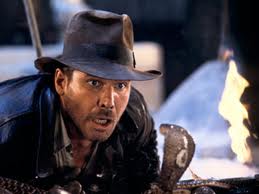One of the points I try to emphasize in my ‘Creative Spark Sessions’ is that the successful artist approaches their work with the mindset of the Explorer. This is something I constantly have to work at myself, and also something I thought I might write about here because I’m not sure that many non-artists really understand it.
Once an artist understands most of the technical aspects of making art, the question becomes: What do I want to say and how do I best say it with my art? Once that goal is identified, the adventure begins. Where will the art take you? When I go off to teach a class or work in the studio, I often hear from friends and family “Have Fun!”
While I am motivated to create and I enjoy the creative process and its results, I wouldn’t describe it as fun exactly. If you came upon Indiana Jones in the bottom of a pit full of writhing snakes as he tried desperately to save the treasure of the Ark of the Covenant AND the love of his life, I doubt you would say ‘Have Fun!’
Granted, making art is not a life or death event. But the rewards of a successful painting and the discoveries we make about ourselves, our world and our own process are worth the quest. Just like William Clark and Meriwether Lewis as they set out on the Oregon Trail, the artist can prepare for success. There is no guarantee of a good painting, but if you have a clear goal in mind, plan, take along a good guide and have a sense of adventure your risk may be worth it.
What risks does the artist take? Each step along the way brings new choices. Here are just a few:
- color
- texture
- shape
- line
- value
- size
- direction
And each new brush stroke or mark can make or break the painting. Past experience can guide you, but there is no map, no pattern to follow, no recipe for success. Each painting is a new country every time for every artist. Following another artist’s path or process can be a good way to learn survival skills, but it won’t ultimately satisfy like making your own discoveries.
Some artists take more risks than others. Many artists work is constantly evolving and gradually changing. Picasso had his ‘blue period’ then moved on to other explorations. Others have found an artistic language that fits their temperament and a subject matter that they can explore endlessly. Hopper had a fascination for light on objects and night-time effects. Some artists make work that describes their external world, others are more interested in internal emotions, some try for both.
Whatever the reason for making art, the sense of discovery keeps us coming back again & again. Solving problems during the painting process is not ‘fun’ but it is rewarding! And even more rewarding is when a painting you’ve brought into the world touches someone. When someone buys a painting, I know that they ‘get me.’ Something I’ve said with painting about how I see the world speaks to them.
I’d be interested to hear your thoughts on this subject. You can read more about my explorations in my next post. It’s been so long since I’ve written that I probably need to split this into two segments!




Well said, Ruth. I love the analogy of adventure. I believe art making can literally be life to us and a form of death when we ignore our desire to create. Consider the woman diagnosed as catatonic who was “brought back to life” when her sculptures were discovered in an old barn and returned to her. The act of holding and remembering her work mitigated her condition, (documented in autobiographical memory studies). When we are driven to make art and continually push the feelings away, we often suffer a metaphysical or spiritual “death” and become as walking dead when the force that animates us is continually suppressed. Not to mention very cranky. The drive to create is a powerful life force.
I really enjoyed today’s post, and look forward to the next. I love hearing about another artist’s viewpoint, struggles and victories!